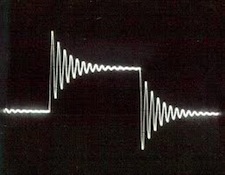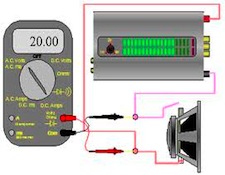It’s the time of year for saving money!

Why Speaker Cables Are More Than You Think They Are
by Roger Skoff
What the heck is a “damping factor,” and who cares?
Every audiophile has heard the term “damping factor,” and most
know that it has something to do with power amplifiers or with the amplifier
section of a receiver. How many of us, though, actually know what a damping
factor is or why it’s important?
Here’s a clue: “Dampness” has nothing to do with it.
The “damping factor” of an
amplifier is the number that indicates how well it can control (“damp out”)
unwanted movement of a loudspeaker diaphragm, and the bigger that number is,
the better.
One of the problems with speakers is that the moving part (the
“diaphragm”) of all loudspeaker drivers, even ribbons, electrostatics, and other
“planars”, has mass, and that mass, once it starts moving, wants to keep on
moving, even after the force driving it stops. That is one of the aspects of
the phenomenon we call “inertia” (“the tendency of a moving object to stay
moving and an object at rest to stay at rest”), and it can have a profound
effect on the sound of your system.
The greater the mass of the diaphragm (the “cone”, for most
speakers) and the more or farther that mass is moving, the greater the inertia
that has to be overcome in accelerating and decelerating it to follow (and only
follow) the signal fed to it by the amplifier. Because the biggest (most
massive) drivers in a speaker system are its woofers, and because bass signals
require the most cone movement to produce, bass response is the thing most
affected by an amplifier’s damping factor.

To calculate your amplifiers damping factor (at least as it is
given on amplifier spec’ sheets) is easy: Just divide 8 Ohms, the nominal
“standard” loudspeaker impedance, by the stated output impedance of your
amplifier. If the amplifier’s stated output impedance is .01 Ohm, it has a
damping factor of 800 (8 divided by .01 = 800), which is very good but not
exceptional for a solid-state amplifier. (Tube amplifiers tend to have higher
output impedances, and therefore lower damping factors)
In reality, though, the calculation method just given overlooks
two very important facts: First, not all or presently even most loudspeakers
have nominal impedances of 8 Ohms. Second, and even more importantly, no true
calculation of amplifier damping factor can be complete without including the
speaker cable into the equation
Three elements are involved in driving a speaker; the speaker
itself, the speaker cable, and the amplifier.
In calculating an amplifier’s actual damping factor, all of them must be
considered.
What makes it interesting is that the three elements act as if
they were just two, and, surprisingly, those two are not what you might think:
Instead of the loudspeaker and the cable being one element and the amplifier
being the other, in reality it’s the loudspeaker that stands alone, and the
combination of the speaker cable and the amplifier is the other element.
To understand how this can affect the amplifier’s true damping
factor, and, ultimately, the sound of the entire System, consider this: The
resistance (not the impedance, but just the measured DC resistance) of a 10
foot run of a typical cheap 24 gauge “speaker cable” is about .51
Ohms. If we add this to the .01 Ohm
output impedance of the amplifier I mentioned earlier, we come up with an
effective output impedance of .52 Ohms. If we then divide this into the
“standard” speaker impedance of 8 Ohms, we get a true damping factor
of only 15.4, instead of the 800 shown on the amplifier’s spec sheet. To make things even worse, if we’re using a speaker’s
with a nominal impedance of 4 Ohms, instead of the “standard” of 8
Ohms, the true damping factor is reduced even more — to just 7.7. (4 divided
by .52 = 7.7)
This is a fine example of why using cheap or bad speaker cable
can make a speaker’s bass sound “flabby” or uncontrolled… it
actually is uncontrolled.
By contrast, a 10 foot run of one quality high end 10AWG gauge
cable can have a total resistance of just .02 Ohm. Adding this to the
amplifier’s output impedance of .01 Ohm gives a total of only .03 Ohms, which,
divided into the 8 Ohm standard speaker impedance gives a true damping factor
of 267 — better than 17 times the speaker control available from the lesser
cable. That’s one of the key reasons why high end speaker cables sound better.
About Roger Skoff
Roger Skoff is the
founder of XLO Cables. The company was sold in 2002. Roger is not
currently affiliated with any audiophile companies directly but is still
passionate about the hobby of audiophilia.






Steven, I have to correct one error in your About Roger Skoff
section at the bottom of the page. You say “Roger Skoff is the founder
of XLO and Ultralink Cables.” Roger founded XLO but not UltraLink who
bought Roger’s company in ’02. Thanks.
Done
Thanks!
I’m still a cable sceptic. Using Belden/BJC 12 gauge with locking bananas in seven foot pairs. Have tried other low cost brands and like these very much.
how does this translate when using a wireless connected sub?
To all cable skeptics: do me a favor and just grab some good cables from a friend for the weekend, put them in your rig, and listen. If you don’t hear any difference, use zip cord. Enough about cable skeptics already. To Mr. Skoff: I can buy 10AWG wire pretty cheap – what is it that makes audio cables expensive? And why are certain cables (like Audience) “skinny” – i.e., not using 10 AWG or similar cables?
i find this article insulting. the whole content of the article describes how cable length and guage effect damping factor…then he ends saying “this is why high end speaker cables sounds better” (a completely random statement) …i think if he didn’t have an agenda, he would end the article saying: “that is why you should try to keep cable lengths as short as possible and of the appropriate thickness”
agreed. it’s a joke.
With ya 100%,,,,Ever see the blind test where they couldn’t tell the difference between the most exspemsive monster cables and a pair of straightened out coat hanger wires?